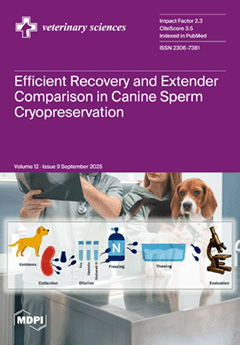Among the main diseases affecting dairy cattle is mastitis, a pathology widely recognized worldwide for causing considerable economic losses for both producers and the dairy industry. The conventional treatment involves the use of antibiotics, for which bacterial resistance has been reported. This fact
[...] Read more.
Among the main diseases affecting dairy cattle is mastitis, a pathology widely recognized worldwide for causing considerable economic losses for both producers and the dairy industry. The conventional treatment involves the use of antibiotics, for which bacterial resistance has been reported. This fact has created the need to propose alternative treatments for this disease. Among the bacterial microorganisms associated with bovine mastitis are
Streptococcus spp. and coagulase-positive
Staphylococcus, which were isolated from milk obtained from cattle with mastitis in different dairy farms in the sector of Anaime in Cajamarca, Tolima. The objective of this research was to provide information on the antibacterial activity, toxicity, and phytochemical study (by TLC) of the following five plants—
Calendula officinalis L.,
Psidium guajava L.,
Matricaria chamomilla L.,
Rosmarinus officinalis L., and
Carica papaya L.—cultivated in Tolima, Colombia, with ethnopharmacological information in the treatment of diseases of bacterial origin. The ethanolic extracts of the selected species were obtained by maceration and were characterized for the presence of flavonoids by TLC. The antibacterial activity was evaluated in vitro using the Kirby-Bauer disk diffusion technique in Mueller–Hinton agar against
Streptococcus spp. and coagulase-positive
Staphylococcus strains. Ethanolic extracts of
Psidium guajava L. (21 ± 3.2) and
Rosmarinus officinalis L. (19 ± 2.1) showed the best activity against coagulase-positive
Staphylococcus. In addition, ethanolic extracts of
Calendula officinalis L. (21 ± 1.9),
Rosmarinus officinalis L. (17 ± 2.9 mm), and
Psidium guajava L. (15 ± 2.3) were the most active against
Streptococcus spp. In contrast, the ethanolic extract of
Matricaria chamomilla L. showed no activity against the strains evaluated. All extracts showed toxicity against
Artemia salina nauplii at 24 h. It is important to mention that flavonoids were detected using TLC in all the extracts, which may be associated with antibacterial activity.
Full article






